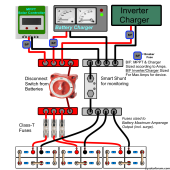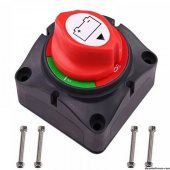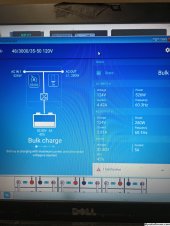You are using an out of date browser. It may not display this or other websites correctly.
You should upgrade or use an alternative browser.
You should upgrade or use an alternative browser.
Battery cutoff switch on negative or positive cable?
- Thread starter Thodoris
- Start date
It likely won't matter, but I use the positive side.
42OhmsPA
What's in a title?
+1 for +.
What voltage is your switch rated for, do you have a link to it?
What voltage is your switch rated for, do you have a link to it?
It's rated for 48V systems, it's an OEM switch.+1 for +.
What voltage is your switch rated for, do you have a link to it?
But the same rating applies for the VICTRON switch which is much more expensive.
Looks the same as this one: https://www.amazon.com/Master-Battery-Switch-Screws-12-48V/dp/B07S8XBZRJ
Last edited:
Steve_S
Offgrid Cabineer, N.E. Ontario, Canada
Blue Sea has similar switches some of which can support 80V (72 Volt system). WARNING, there are cheap knockoffs out there, be aware of that and don't furtle with switches, breakers or fuses, that is NOT where to pinch pennies.
 www.bluesea.com
www.bluesea.com
Below is one my generic diagrams to help you out.

Battery Switches - Blue Sea Systems
Engineering high quality marine electrical components for safety, reliability and performance
Below is one my generic diagrams to help you out.

timselectric
If I can do it, you can do it.
- Joined
- Feb 5, 2022
- Messages
- 18,862
If a switch is only rated for a maximum of 48v.
It's not safe to use on a system with a voltage higher than 48v.
It's not safe to use on a system with a voltage higher than 48v.
Thanks for the help regarding voltage rating.
I was also not happy from the replies i was getting from Victron. When i asked them about their 48V switch they were not clear and they never told me that I CANNOT USE their switch for my system. I was thinking that 48V was the nominal voltage rating, but i think it's dangerous to go on with that.
So i found this one which is rated up to 60V. What do you think?
 www.expondo.co.uk
www.expondo.co.uk
I was also not happy from the replies i was getting from Victron. When i asked them about their 48V switch they were not clear and they never told me that I CANNOT USE their switch for my system. I was thinking that 48V was the nominal voltage rating, but i think it's dangerous to go on with that.
So i found this one which is rated up to 60V. What do you think?
Expondo shop
Top service ✓ Very reliable ✓ No delivery costs ✓ | Buy now your for a low price !
Steve_S
Offgrid Cabineer, N.E. Ontario, Canada
When looking at these switches the Big Detail to watch for is not the Label that says 12V/24V or 48V... That is kind of a misnomer because for example a 24V LFP system must have a switch that can handle 30V, just like a 48V system has to handle 60V. 12/24/48 are Legacy from Lead Acid days but still used as the common reference.
Looked at the Specs PDF and that appears to be acceptable. I say appears, as this is a brand I have never heard of and do not knows its origins.
Looked at the Specs PDF and that appears to be acceptable. I say appears, as this is a brand I have never heard of and do not knows its origins.
timselectric
If I can do it, you can do it.
- Joined
- Feb 5, 2022
- Messages
- 18,862
It says it's rated high enough.Thanks for the help regarding voltage rating.
I was also not happy from the replies i was getting from Victron. When i asked them about their 48V switch they were not clear and they never told me that I CANNOT USE their switch for my system. I was thinking that 48V was the nominal voltage rating, but i think it's dangerous to go on with that.
So i found this one which is rated up to 60V. What do you think?
Expondo shop
Top service ✓ Very reliable ✓ No delivery costs ✓ | Buy now your for a low price !www.expondo.co.uk
If you trust the brand, it should be fine.
HalfBaked
Ever the student
timselectric
If I can do it, you can do it.
- Joined
- Feb 5, 2022
- Messages
- 18,862
I thought that most were. But you would have to check the specs.Do you know of any specific model from Blue Sea that can go to 60V or more?
I’m not seeing anyDo you know of any specific model from Blue Sea that can go to 60V or more?
42OhmsPA
What's in a title?
Great info by others already. I asked about the voltage because it's tough to find something rated for 60v, I went down the same path recently.It's rated for 48V systems, it's an OEM switch.
But the same rating applies for the VICTRON switch which is much more expensive.
Looks the same as this one: https://www.amazon.com/Master-Battery-Switch-Screws-12-48V/dp/B07S8XBZRJ

60V Disconnect disconnection overload?
I'm planning ahead for adding my 3rd pack and having trouble deciding on a proper disconnect. I attached a crude diagram of the planned setup and a photo of how things sit currently (expect the SRNE is in service) the packs will be reconfigured and put in some sort of enclosure / rack / cabinet...
It's even harder to find one that's UL listed. I searched all over Amazon recently looking for a DC breaker switch, and couldn't find one that was 100A+, 60V+, and UL Listed. I seriously considered one that was around $140, which seemed way too high. It looked high quality, but I couldn't find anywhere that it was UL Listed.Great info by others already. I asked about the voltage because it's tough to find something rated for 60v, I went down the same path recently.

60V Disconnect disconnection overload?
I'm planning ahead for adding my 3rd pack and having trouble deciding on a proper disconnect. I attached a crude diagram of the planned setup and a photo of how things sit currently (expect the SRNE is in service) the packs will be reconfigured and put in some sort of enclosure / rack / cabinet...diysolarforum.com
I like the one that you linked in that thread.
Blue Sea has similar switches some of which can support 80V (72 Volt system). WARNING, there are cheap knockoffs out there, be aware of that and don't furtle with switches, breakers or fuses, that is NOT where to pinch pennies.
I can say from experience, that the Chinese/Amazon/Ali Expr. knockoffs costing around $10,00-$20,00 are a waste of your money.
If you run more than 40-50 amps through those cheap switches, then they easily heat up to 90 degrees C/194F. (measured with Flir)
And if you measure the voltage drop between the switch terminals, you certainly don't want to use it anymore.
Most of these switches are marketed for marine or automotive applications with lead acid batteries. 48 volt rating is adequate. I believe over 50 volts is considered high voltage so rating at 60 volts would probably require additional testing.
Some of the Chinese offerings claim 60V, but I wouldn't believe it.
I'm going with a BEP 701-PM by Marinco. It's only rated 48V, but I can be sure that it is truly capable of 275 A. I'm only adding this switch in case I need to deploy a pre-charge resistor. Also to isolate the class T fuse for replacement. There's a code for ESS requiring fuse isolation, so the layman can safely change the fuse. NEC 706.21(E)
Some of the Chinese offerings claim 60V, but I wouldn't believe it.
I'm going with a BEP 701-PM by Marinco. It's only rated 48V, but I can be sure that it is truly capable of 275 A. I'm only adding this switch in case I need to deploy a pre-charge resistor. Also to isolate the class T fuse for replacement. There's a code for ESS requiring fuse isolation, so the layman can safely change the fuse. NEC 706.21(E)
Last edited:
timselectric
If I can do it, you can do it.
- Joined
- Feb 5, 2022
- Messages
- 18,862
It really doesn't matter what amperage it's rated for. If it can't safety disconnect the voltage going through it.
But at a higher amperage, the voltage rating is even more important. Because more amperage can be flowing through the arc. That is created by the under rated disconnect.
But at a higher amperage, the voltage rating is even more important. Because more amperage can be flowing through the arc. That is created by the under rated disconnect.
Similar threads
- Replies
- 3
- Views
- 538
- Replies
- 20
- Views
- 782
- Replies
- 5
- Views
- 197
- Replies
- 2
- Views
- 262




